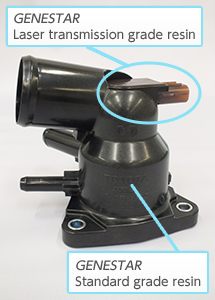News
News by Year
Kuraray Co., Ltd. (Headquarters: Chiyoda-ku, Tokyo; President: Masaaki Ito; "Kuraray") today announces the expansion of applications for GENESTAR, a highly-functional polyamide resin that the Company developed, to include auto parts due to its high laser transmittance. Going forward, we aim to expand use of this resin in electric and electronic components.
About GENESTAR
- Kuraray’s development of this proprietary heat-resistant polyamide resin began with the creation of raw material monomer. In 1999, Kuraray became the first in the world to successfully commercialize such a material, PA9T, which it launched under the name GENESTAR.
- GENESTAR is highly resistant to heat, chemicals and friction while boasting low water absorption and superior electrical insulation.
- Thanks to these features, GENESTAR is used for connectors in smartphones, personal computers and other electric and electronic appliances as well as to make LED reflectors. Moreover, it is gaining popularity in the automotive industry in harmony with growing demand for lightweight vehicles. Specifically, GENESTAR is widely used for cooling system components, fuel tubes and other auto parts, providing a lightweight alternative to metal. In recent years, the use of this resin in automotive electronics has been growing.
About Laser Transmission Grade Resins
- To make cars lighter and more fuel efficient as well as improve functionality, resin components are increasingly being integrated into auto parts. Such integration, in turn, means that more secondary components like bolts or adhesives are needed to build auto parts from the new components.
- Heat welding, however, provides a solution that precludes the need for secondary components. Other types of welding, for example, vibration welding, ultrasonic welding and hot plate welding, all require weld ribs or similar specialized features to be included in parts design, and may result in welding burrs and damage to internal components. Laser welding, in contrast, poses no such dangers.
- Among engineering plastics, GENESTAR boasts exceptionally high laser transmittance. Because its weldability is not generally restricted by its thickness (fig. 1), there is more freedom in terms of component design. In addition, it is also possible to use this material for components that were originally difficult to weld.
- Since the first use of GENESTAR in a cooling component (fig. 2) for Toyota Motor's new V6 engine last year, applications in highly functional automotive components have increased, helping make cars lighter and more functional. Going forward, we aim to expand use of this material beyond auto parts to include a wide range of applications, including electric and electronic components.
![[GENESTAR+GF35%(circle)]Thickness of welding section-1mm:Transmittance68% Thickness of welding section-2mm:Transmittance49% Thickness of welding section-3mm:Transmittance32% [PPA+GF33%(triangle)]Thickness of welding section-1mm:Transmittance26.5% Thickness of welding section-2mm:Transmittance13% Thickness of welding section-3mm:Transmittance7.3% [PPS+GF30%(square)]Thickness of welding section-1mm:Transmittance20% Thickness of welding section-2mm:Transmittance8.8% Thickness of welding section-3mm:Transmittance4.4%](/uploads/5c3da1e9a4bd4/161109_01.png) Fig. 1. Laser transmittance of engineering resins.
Fig. 1. Laser transmittance of engineering resins.
* Image download service for the news media
We provide the ability to download images by clicking on them exclusively to the news media.
Please contact the Kuraray Corporate Communications Departmentif you wish to use this service.

